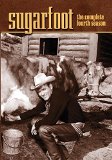| Reviews & Columns |
|
Reviews DVD TV on DVD Blu-ray 4K UHD International DVDs In Theaters Reviews by Studio Video Games Features Collector Series DVDs Easter Egg Database Interviews DVD Talk Radio Feature Articles Columns Anime Talk DVD Savant Horror DVDs The M.O.D. Squad Art House HD Talk Silent DVD
|
DVD Talk Forum |
|
|
| Resources |
|
DVD Price Search Customer Service #'s RCE Info Links |
|
Columns
|
|
|
Sugarfoot: The Complete Fourth Season (Warner Archive Collection)
He never did pass the Bar. Warner Bros.' Archive Collection line of hard-to-find library and cult titles has released Sugarfoot: The Complete Fourth Season, a two-disc, nine-episode collection of the WB/ABC oater's final 1960-1961 round-up. Its normal number of episodes whittled down by more than half to accommodate a final move back under the Cheyenne umbrella (along with Bronco, as well), Sugarfoot didn't have a lot of time to impress viewers this season...who were deserting the show in increasing numbers. The talented Will Hutchins--he deserved a higher-profiled career--occasionally can be caught looking mighty bored, even though the scripters deliver up some entertaining outings. No extras this go-around (someone couldn't have called up Hutchins--still going strong out there--and got a commentary track or two out of him?), while the fullframe black and white transfers are predictably nice and crisp.
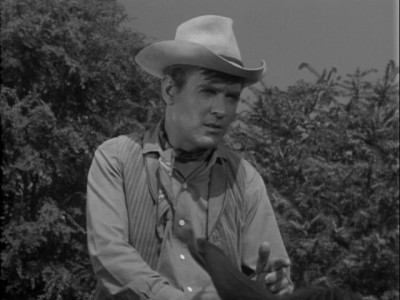
For newcomers to the show, quite frankly...the free-wheeling Sugarfoot has very little backstory to summarize: stand-alone "anthology" story-telling is the name of the game here. Young Tom Brewster (Will Hutchins), who grew up in the East and has come West to make his fortune, is a gentle, intelligent, thoroughly ethical young man dedicated first and foremost to "the law": pistol-work, fancy roping, showy duds and livery, the manly arts of fighting and loving--none of those skills and accoutrements of the typical TV Western hero appeal to Tom as much as peaceably righting a wrong against someone. Studying to become a lawyer through correspondence courses, Tom is a'gin killing, no matter what the circumstances, and that's why his law books are more accessible than his pistol and rifle. That diffidence to fight in this savage, hot-headed land--he'll tussle if he has to, though, boy--is also why he's garnered the nickname "Sugarfoot," a pejorative in the rowdy Old West that's even lower on the masculinity scale than the despised "Tenderfoot." Easygoing Tom, however, doesn't give a hoot about the nickname...particularly since he always comes out on top of his sticky, often-times deadly situations and confrontations.
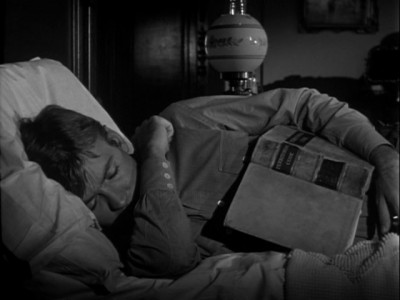
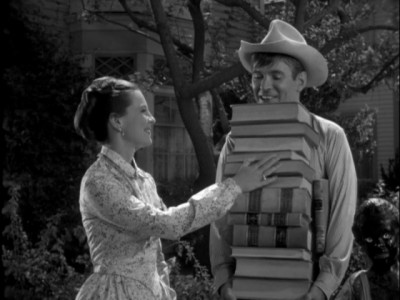
I've written twice before about Sugarfoot, so I'll try not to go over the same ground again. If you've read my reviews for Cheyenne, Bronco, and Sugarfoot, then you'll know that I admire the reliable professionalism of the "boiler plate" style of Western-making that came to be identified with these WB oaters. It needs no apologies for consistently achieving its aims--mainly: entertaining viewers--over hundreds of hours of television programming. Certainly though, there's no question that after a few years, identifiable story elements began to be repeated (a recognition factor accentuated by the heavy reliance on WB contract players which ultimately created a feeling of "sameness" across the various shows). However, it's equally important to note that most of these episodes were carefully crafted during the writing stage, and professionally executed during production. The actors toiling in the sausage factory grind of television production back then (sun-up to sun-down shooting, six days a week, week in and week out...and for not nearly as much pay as you might think) may not have seen it that way--Hutchins at one time was quoted as saying: " [the Sugarfoot episodes] are pretty much the same after you've seen a handful. They're moneymakers for the studio, the stations, and the actors, but there's a kind of empty feeling when you're through." However, seen in context against a lot of slipshod product out there now, what actors like Hutchins and Walker and Garner saw as unimaginative, repetitive drudgery then...looks pretty good today. Why exactly Sugarfoot was cancelled after four seasons is easy to state: its Nielsen numbers weren't the match of either Cheyenne or Bronco (being seen only once every three weeks or so, as opposed to every other week, obviously didn't help, either). Determining why people tuned out is harder to guess. If I had to pinpoint the most obvious problem with the series at this final juncture, it would be the producers and writers refusal to either stick closely with the show's format (Tom Brewster the naive, violence-hating law student has flown the coop by this point in the show), or to take the Tom character to another equally memorable level (for this fourth season, Tom does more shooting and fist-fighting than he does law book-reading, leaving him largely indistinguishable from all the other hard-headed cowboys on the dials looking for eyeballs and Nielsen numbers at that time). The Tom character no longer has an unusual, and thus easily recognizable, "hook," while his vague, shadowy transformation isn't distinctive enough for us to stick around and take a second look.
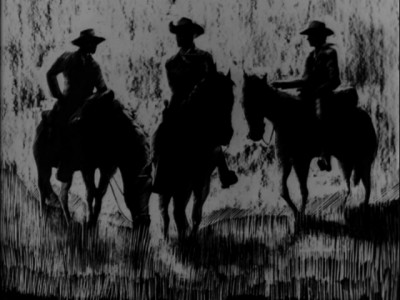
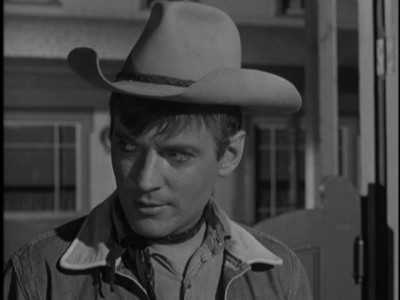
A note about Sugarfoot's complicated production history would be in order at this point as well, to help explain that limited number of only nine episodes for this fourth season...which technically could also be referred to as the first season of The Cheyenne Show. As fans know, Sugarfoot was created expressly to give the Cheyenne production crew a break, if you will. Cheyenne, WB's and ABC's big hit Western starring Clint Walker, needed six days minimum to shoot an hour-long episode, so when alternating episodes of Kings Row and Casablanca (which were featured with Cheyenne in 1955 on the Warner Bros. Presents anthology show), as well as Conflict, in 1956, were all cancelled, the highly popular Western still needed an alternating companion series to help meet air dates. That's when Sugarfoot was created, in 1957. In 1958, however, Clint Walker, tired of his penurious WB contract, walked out on Cheyenne, forcing the studio to simply plug another character into the show--Ty Hardin's "Bronco Layne"--where the still-monikered Cheyenne continued to alternate with Sugarfoot (to even better ratings for Will Hutchins). When Walker came back to Cheyenne in '59, Hardin was given his own show called appropriately, Bronco, and it began to alternate with Sugarfoot on a separate night...while Walker's Cheyenne, amusingly, alternated with Shirley Temple's Storybook (don't tell me Jack Warner didn't have a sense of humor). Ratings for the Bronco / Sugarfoot combo dropped, however, so in the fall of 1960, both shows were plugged back in with Cheyenne under an umbrella title, The Cheyenne Show. That's why only nine episodes of Sugarfoot were ordered for this fourth--and ultimately last--season (at the end of the 1960-1961 season, the Sugarfoot component was cancelled, with Bronco alternating on The Cheyenne Show for 1961-1962...before it, too, was cancelled, and just a few months of new Cheyenne-only episodes aired during the 1962-1963 season).
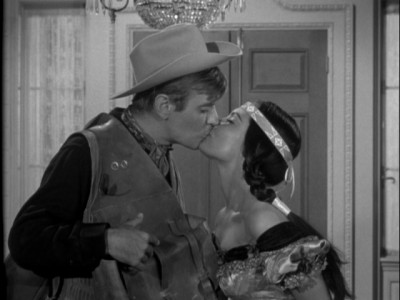
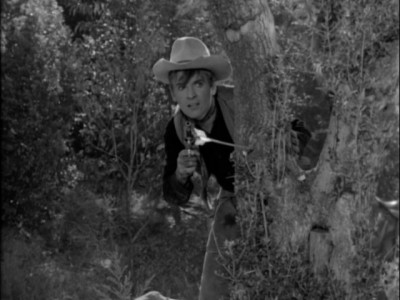
Kick-off episodes this tonally fractured don't exactly encourage loyal viewers to stick around, either. The Shadow Catcher, from Warren Douglas, starts out just fine: Tom becomes an Indian agent, where he's soon caught up in a treaty dispute between the U.S. government and the Sioux (whom he states right up front are his "brothers"). A serious vibe and an uncomfortable message--the Indians are all-too familiar with how their treaties are kept with the government--gives way, somehow, to a comedy outing where Tom is rescuing Nina Shipman in the best F Troop fashion. I don't have a problem with either approach to the story (if comedy was out, I wouldn't have had the chance to see one of my all-time favorites, James Millhollin, do his hilarious nervous nelly shtick). However, the transition from heavy to light is abrupt and artless here, stranding the viewer in the process. Tom's back to lawyerin' in A Noose for Nora, from Lester Fuller. Unsurprising in its predictable twists and turns, this courtroom episode at least gets Hutchins back to the show's original conception. Warren Douglas' Man from Medora finds WB contract actor Peter Breck making a memorable appearance as young Teddy Roosevelt looking to master cattle ranching...with Tom's help. Breck's the whole show here with his broad-but-well-tuned portrayal of Roosevelt (just as he stole all those Maverick episodes with Jack Kelly, playing Doc Holliday), while Hutchins clearly looks put out (if the writers and producers aren't giving their talented leading man enough to do, and in walks a guest star with a showy, well-written part...well, do the math). Old timer Rosco Ates, though, gets the biggest laugh in the smallest amount of time as a barber with a bad case of the shakes. Unlike the season opener, Welcome Enemy, from Roger Costa, achieves the right balance of humor in this season best offering. Tom, tapped to facilitate a pow-wow between Sioux chief Red Wing (Glenn Strange) and President U.S. Grant (J. Edward McKinley), escorts the Chief and his pretty interpreter/daughter, White Feather (Suzanne Lloyd), to a swank hotel in Chicago, where Tom has to protect the Chief from an assassination attempt. The laughs increase when White Feather has designs on the kind, charming Tom...who's also fending off the attentions of pretty Janet Lake, the daughter of a visiting general. At times akin to a fast-paced bedroom farce, Welcome Enemy hits all the right notes here, from suspense to comedy, with Hutchins excelling at his own brand of "aw shucks" geniality masking a thoroughly competent man of action (watch for former short subject star Grady Sutton doing his patented "sissy" act--to solid laughs).
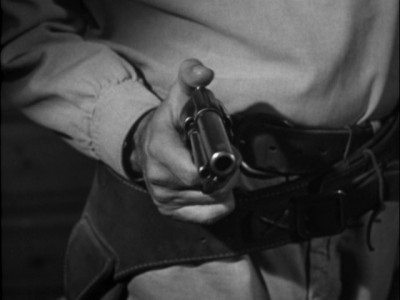
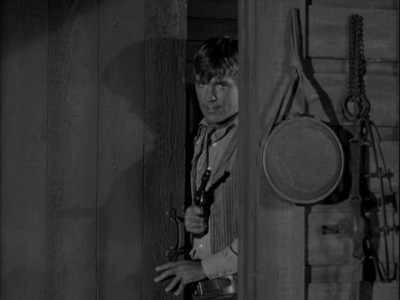
A welcome addition to Sugarfoot comes in Toothy Thompson, from Warren Douglas, when Jack Elam's same-titled character teams up with Tom for a familiar but well-executed murder mystery, with a corrupt government background. Providing Tom with a potential sidekick is a big break from Sugarfoot's original conception: after all, it's just supposed to be Tom, wandering the West while learning about life and the law. However, the final fade-out makes it clear that Tom wants Toothy to ride along with him, indicating to the viewer that the two cowpokes are now a team. Why this happened is anybody's guess (I'm betting someone made the decision as a last-ditch attempt to stem the ratings bleed), but at least in this episode, it's a good match. Hutchins and Elam work quite well together...although one might assume that Hutchins quickly found out what a lot of leading actors discovered when working with the spectacularly ugly, animated Elam: all eyes went to him and stayed there. Hutchins gets to be gruff and gentle with Elam in equal measure (Hutchins has a great scene where he discusses an ugly dog he once had, making the pathetic Elam feel better about himself), while Elam gets all the laughs. That's why it's all the more mysterious that Elam then disappears for the next episode, only to return in the following one...but only as a friend of Tom's, and not as his sidekick.
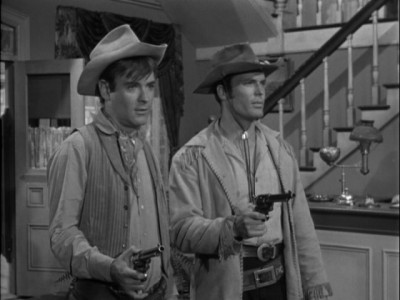

Shepherd with a Gun, from Warren Douglas, is a surprisingly grim, mordant little tale that benefits from the downbeat atmosphere created by cult B movie director Lew Landers. Tom becomes involved with Mexican sheep herders Rafael Campos and Linda Dangcil, who are targeted for death by bitch-on-wheels Nancy Hadley, a ball-breaker who completely controls her father, Regis Toomey. While Hutchins discusses what it means to be a man with Campos, revealing a heavily-depressed, guilty conscience for the various killing Tom's done (very unusual for this series), Hadley camps it up like she's in a nasty B noir, spitting out lines like, "I just can't stand a loser!" to potential lover Don Haggerty, while eyeing up Hutchins. Lots of violent action in this one, including vicious fistfights and a blasting, lightning-fast fanning shoot-out at the end. A series best entry, and most welcome at this point in the series. Jack Elam's "Toothy" returns for Angel, from Warren Douglas, but he doesn't ride into town with Tom--he's already there when Tom is summoned by old friend Sheriff Frank Albertson to help clean up a corrupt town. Elam again effortlessly steals every scene he's in (I wonder how Hutchins felt about that), pulling off "funny" and "sweet" simultaneously in his rather touching love scenes with the skilled Cathy O'Donnell. I loved seeing one of my all-time favorites, Percy Helton, adapting his repulsive, hilarious whining act to a villain part, but the sudden crossover appearance of Ty Hardin as Bronco Layne accomplishes nothing (he barely has five lines, nor does he look all that thrilled to be there, either). At the episode's end, with Toothy nursing his soon-to-be-bride back to health as Tom rides off, it's clear that whomever once thought of pairing up Elam and Hutchins as a team, had changed their mind. Lester Fuller's Stranger in Town has one or two nice little plot twists (that European reversal of month and date when written is pretty good) in an otherwise routine outing for Hutchins (director Lew Landers returns, and tries to keep the pace up). Finally, Trouble at Sand Springs, from actor Leo Gordon and Paul Leslie Peil, closes out the Sugarfoot story appropriately enough with another courtroom trial episode, one that finds Tom representing an already-hated family set up by an embezzling bank employee. Not bad as they come...but certainly nothing special, either. And not anything that would have convinced the Brothers Warner to keep Sugarfoot around for another year.
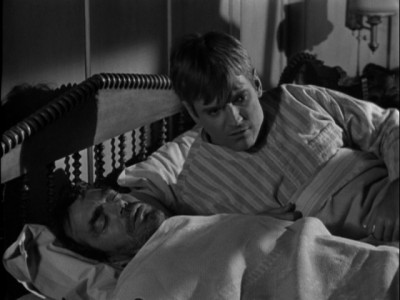
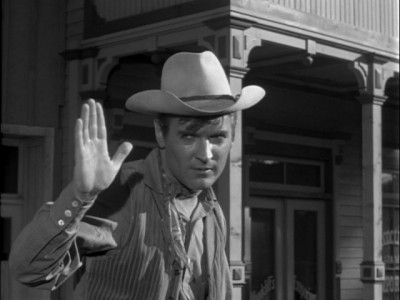
The Video:
For the most part, the fullscreen, 1.37:1 black and white transfers for Sugarfoot: The Complete Fourth Season look very good (there's a section of Welcome Enemy that's really contrasty, but it's brief), with reasonably solid blacks, minimal grain, and few imperfections.
The Audio:
The Dolby Digital English mono audio track is acceptable, with low hiss and a reasonable re-recording level. No closed-captions or subtitles available.
The Extras:
No extras for Sugarfoot: The Complete Fourth Season.
Final Thoughts:
The end of the line for Sugarfoot...so time to start cranking out Lawman and Colt .45 DVD sets, WB. With a lead actor as talented as Will Hutchins at the helm, it's a shame more care wasn't taken with his character (I can hear Jack Warner kicking me out of his office right now). Still...it's not surprising that Sugarfoot ended by this point: everyone looks (and sounds) pretty played out as it is. I'm recommending Sugarfoot: The Complete Fourth Season for fans of the show.
Paul Mavis is an internationally published movie and television historian, a member of the Online Film Critics Society, and the author of The Espionage Filmography.


|
| Popular Reviews |
| Sponsored Links |
|
|
| Sponsored Links |
|
|
| Release List | Reviews | Shop | Newsletter | Forum | DVD Giveaways | Blu-Ray | Advertise |
|
Copyright 2024 DVDTalk.com All Rights Reserved. Legal Info, Privacy Policy, Terms of Use,
Manage Preferences,
Your Privacy Choices | |||||||









